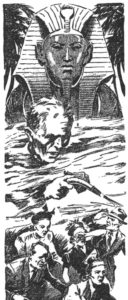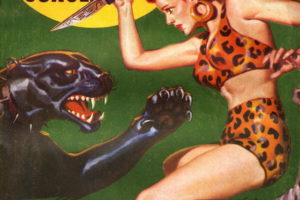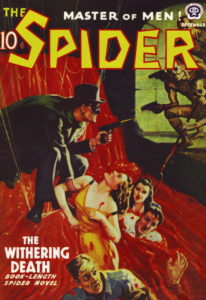
“The Withering Death” was originally published in the December 1938 issue of The Spider Magazine. The dry, ghastly severed hand brought its grisly warning to New York. Its citizens must pay the extortioner’s price or die, their living bodies slowly, agonizingly transformed into rigid mummies! The police were helpless, and only Richard Wentworth, in The Spider‘s weird garb, could wage battle — against the master murder-chemist who killed to corral a fortune!
A very enjoyable romp with The Spider. As usual, the action is pretty much non-stop. The plot is typically over-the-top, very typical of the “weird menace” type of story. I’ve always compared The Spider with The Shadow as follows: The Shadow is based in reality, for the most part; The Spider is based on fantasy. Think of The Spider as The Shadow on steroids. Yes, there are plot holes. And yes, there are some loose threads at the end. But the story moves so quickly that you hopefully won’t notice them too much.
A friend of Richard Wentworth’s receives the hand of a mummy. Burned into the back of that hand is Disobedience means death! Now, that’s some warning. Later he gets a call from Kenneth Rockwell, head of the Egyptian Department of the Consolidated Museum. He’s gotten message from his fiance, Sue Warrington, and it’s obviously fake. When Wentworth shows up at the museum, the two men are attacked by a mummy… a living mummy that suddenly expires. When Rockwell turns the now-dead mummy over, he sees the face of his fiance, Sue Warrington.
Yes, someone is turning people into living mummies! But they don’t live for long. In less than 15 minutes they go from being normal, healthy humans to dry, wizened mummies. It turns out that someone has discovered a ghastly secret. They can turn men and women into mummies, and they are using that to extort millions from them. If they don’t pay up, they are turned to mummies.
Before the story is over, thousands have died from the Withering Death. But Richard Wentworth, and his alter-ego The Spider, will finally unmask the demon who controls the terrible mummy fluid.
And now, for some of the plot inconsistencies
Police Commissioner Stanley Kirkpatrick is good friends with Richard Wentworth. He has long suspected that Wentworth is The Spider, and should he ever be able to prove it, he will arrest him. So when a doctored photograph showing Wentworth in The Spider costume is printed on the front page of the Chronicle, he sends out a bulletin: Take The Spider dead or alive. There’s even a scene, later, where the two face off with aimed automatics, ready to kill. Yet at the story’s end, they both appear to wipe up the gang, and there’s no sign of acrimony. What happened? No explanation.
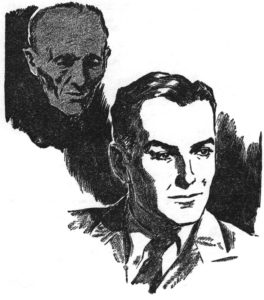
Another time, one of the living mummies jumps onto the running board of Wentworth’s taxicab, carrying a bomb. What’s his motivation? Why would some innocent victim of the Withering Death follow the orders of some unknown mastermind? There’s no indication in the story of mind control. No indication that the victims go insane. If you were turning into a mummy and knew you only had minutes to live, would you try to bomb another guy who you never even knew? I doubt it. More likely you’d be calling your loved ones to say goodbye.
In a later scene, a living mummy enters a drugstore, and starts spraying the air with the pink mist of the mummy fluid. Why is he cooperating with our mass-murderer? As pointed out above, there is no motivation for such horrible acts. It just doesn’t make sense.
Residents living in a large complex are threatened with the Withering Death. Instead of evacuating the place, the police surround it and force the panicked residents to stay inside. Outside that ring of police, hoards of mobsters with tommy guns blast away at any who try to flee, and the police make no effort to stop them. Now that really doesn’t make sense to me.
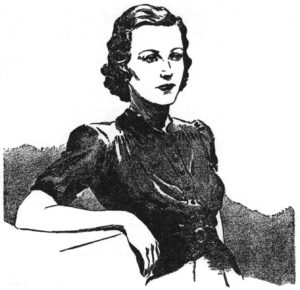
The gang’s all here
All the usual characters are in this one. Nita van Sloan appears and is, as usual, put in peril from which only The Spider can save her. Jackson is his friend and chauffeur, and his role is much like a combination of what Harry Vincent and Moe Shrevnitz were in The Shadow’s pulp tales. Jenkyns, the old butler, mans the secret telephone and keeps his boss in contact with everyone. In The Shadow stories, that’s the Burbank role. Dr. Rogers is the physician who owes Wentworth past favors, and assists The Spider… just like Dr. Rupert Sayre assisted The Shadow. There’s the faithful Ram Singh, the mighty battler who reminds me of Jericho Druke in The Shadow. Ram Singh doesn’t get much to do in this story. He’s thrown in jail early on, and isn’t mentioned again.
Mike Fogarty is a private detective who has helped Wentworth in many occasions in the past. Unfortunately, he dies in this story. So I guess he’s no longer a recurring character

Richard Wentworth is an amazing master of disguise. I lost track of how many times he switched disguises, all using some type of putty upon his face which allows his fingers to rapidly do their work and create a new identity. He appears as traveling salesman Gordon Powell, a regular disguise. Then there’s the underworld character Blinky McQuade, an oldish underworld character and another oft-used disguise. Later he becomes a nameless smooth, round-cheeked Oriental.
The cool stuff
A few neat touches that caught my eye. Wentworth has a special way of picking locks. He has a self-adjusting skeleton key that automatically fits the teeth into the lock’s grooves. He gets to use it twice in the story, and I thought that was pretty clever.
Of course The Spider’s trademark (literally) is the crimson stamp of a spider that he brands onto the forehead of his victims. It’s used twice, here.
There are some really terrific action sequences. One of my favorites was an aerial battle in which The Spider in his amphibian airplane battles a bomber that is intent on dropping huge tanks of the mummy fluid upon a large residential complex. Finally he has to crash his plane directly into the bomber to stop it. And he survives! Wow!
Those pesky dangling threads
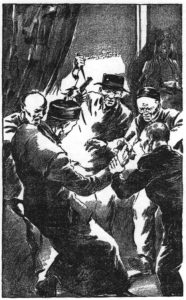
There are unexplained loose ends. Like the mummy’s hidden in Peter Hennessey‘s hidden room. Wentworth and Mike Fogerty, the private detective, secret themselves in a small hidden room behind Hennessey’s fireplace. They find two mummies there. There’s never any explanation. He’s not the mastermind; he’s another victim. So why are the mummies hidden in that place that few people know of? It’s never explained. It turns out that the secret mastermind didn’t know Hennessey, so how did he know about the hidden room in the first place? All unexplained.
When Wentworth returns to his stronghold on Sutton Place, he finds a mummy’s hand that someone has planted in his third-floor living room. The story makes a big deal about how its mysterious appearance is completely impossible. It goes on and on about how the windows only open a few inches; nothing could have entered in that manner. No intruder could have gotten into the building. And on and on. Then, when the story ends, no explanation is made. Readers were assumed to have forgotten about the shriveled old hand, I guess. Why make a big deal about it being so mysterious, if you aren’t going to explain it at the end? Loose end!
As is typical of pulps of that era, there are some racial slurs in the story. Just keep in mind that it is a product of its time, and don’t give it any mind. Historical accuracy, you know.
Verdict: Fun!
This is a fun Spider novel from 1938. Lots of over-the-top action. Richard Wentworth, as The Spider, is really put through the wringer and survives more gun battles and explosions that just about any person could be expected to make it through. It has those cool weird-menace vibes, that I love. Now if only some of the motivations could have been made clearer, and some of the loose ends tied up…
Read it in ebook form… read it in replica form… read the flakey old original pulp… but read it!
